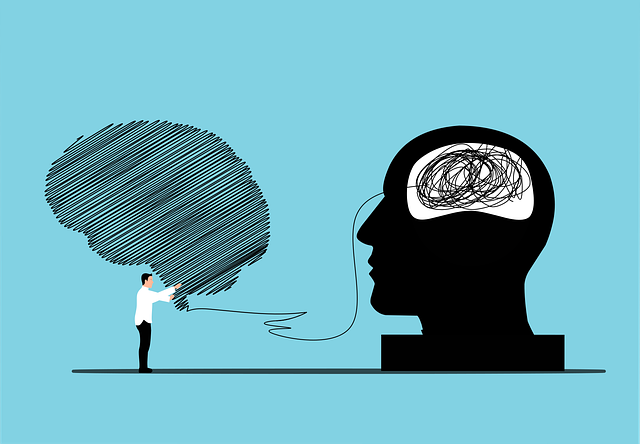Cognitive Behavioral Therapy (CBT) is a powerful therapeutic approach that helps individuals manage and overcome depression and anxiety by targeting negative thought patterns and behaviors. This collaborative process between therapist and client aims to challenge irrational beliefs, foster healthier perspectives, and provide practical tools for emotional management. CBT's effectiveness lies in its understanding of the connection between thoughts, feelings, and actions, ultimately leading to improved mood, reduced anxiety, and enhanced overall well-being. Through techniques like gradual exposure therapy, behavioral activation, and problem-solving, individuals gain the skills to confront fears, engage in activities avoided due to mental health challenges, and achieve long-term mental health success.
“Cognitive Behavioral Therapy (CBT) is a powerful tool in the fight against depression and anxiety, offering a structured approach to healing. This article delves into the intricacies of CBT, providing a comprehensive guide for understanding and implementing this therapeutic technique. From unravelling cognitive patterns to challenging negative thoughts and adopting beneficial behaviours, we explore every step.
Read on to discover how CBT transforms lives, offers real-world success stories, and equips individuals with the skills to manage their mental health effectively.”
Understanding CBT Therapy: A Brief Overview

CBT therapy, or Cognitive Behavioral Therapy, is a highly effective form of psychological treatment that focuses on identifying and changing negative thought patterns and behaviors. It’s a collaborative process between the therapist and client, designed to help individuals manage symptoms of depression and anxiety by understanding how their thoughts, feelings, and actions are interconnected.
This therapeutic approach encourages clients to challenge and replace irrational or unhelpful beliefs with more realistic and positive ones. By learning coping strategies and gaining insights into their mental health, individuals can effectively navigate their emotions and experiences, leading to improved mood, reduced anxiety, and better overall well-being.
How CBT Works for Depression and Anxiety

CBT, or Cognitive Behavioral Therapy, is a highly effective form of therapy that works by helping individuals identify and change negative thought patterns and behaviors contributing to depression and anxiety. It’s a collaborative process between a therapist and client, focusing on the present and future rather than the past. Through CBT, you learn to challenge distorted thinking, develop healthier coping mechanisms, and gradually replace unhelpful habits with more adaptive ones.
This therapy is based on the understanding that our thoughts, feelings, and behaviors are interconnected. By modifying negative thought patterns, one can significantly improve their mood and reduce anxious symptoms. CBT offers practical tools for managing depression and anxiety in everyday life, enabling individuals to take control of their mental health and cultivate long-lasting well-being.
The Role of Cognitive Patterns in Mental Health

Cognitive patterns and thought processes play a significant role in our mental health, especially when it comes to managing depression and anxiety. These patterns are often unconscious and can influence how we interpret situations, leading to negative emotions and behaviors. CBT therapy, or Cognitive Behavioral Therapy, is designed to identify and challenge these unhelpful cognitive distortions. By bringing awareness to these patterns, individuals can learn to replace negative thoughts with more realistic and positive ones, which in turn can reduce symptoms of depression and anxiety.
In CBT, therapists help clients recognize the connection between thoughts, feelings, and behaviors. They work together to uncover the underlying beliefs and thought processes that contribute to distress. For example, a person with social anxiety might have a cognitive pattern where they assume others are judging them negatively. Through CBT, they can learn to challenge this assumption by gathering evidence from different situations, thus reducing their fear and anxiety in social settings. This process empowers individuals to manage their mental health more effectively and foster a healthier relationship with their thoughts.
Identifying Negative Thought Cycles

Many people struggling with depression and anxiety fall into patterns of negative thinking that can perpetuate their distress. Cognitive Behavioral Therapy (CBT) helps individuals identify these thought cycles, which often involve distorted or unhelpful beliefs about oneself, the world, and the future. By becoming aware of these recurring negative thoughts, individuals can begin to question and challenge them, leading to a more balanced and realistic perspective.
Through CBT therapy, clients learn to recognize cognitive distortions like all-or-nothing thinking, catastrophizing, and jumping to conclusions. Once identified, these thought patterns can be replaced with healthier alternatives, fostering a sense of empowerment and improved mood over time.
Challenging Unhelpful Thoughts and Beliefs

CBT for depression and anxiety involves a crucial step: challenging unhelpful thoughts and beliefs. This process begins with identifying negative or distorted thinking patterns that contribute to feelings of sadness, worry, or fear. Once these patterns are recognized, CBT encourages individuals to question and reframe these thoughts. For instance, instead of believing “I always fail at everything,” one might challenge this thought by considering evidence that supports the opposite, like past successes or efforts made towards goals.
By replacing unhelpful beliefs with more realistic and positive ones, CBT therapy enables people to change their emotional responses. This shift in perspective allows individuals to see situations from a different light, fostering a sense of hope and resilience. It empowers them to confront fears and engage in activities once avoided, breaking free from the cycle of depression and anxiety.
Behavioral Techniques in CBT: Activities and Strategies

In Cognitive Behavioral Therapy (CBT), behavioral techniques play a pivotal role in managing depression and anxiety. These techniques involve practical activities and strategies that help individuals challenge negative thoughts and replace them with more positive, realistic ones. One common approach is gradual exposure to feared situations or objects, which can reduce anxiety over time by desensitizing the individual. For instance, someone with social anxiety might start by engaging in low-risk social interactions and gradually work their way up to more challenging scenarios.
Another effective strategy is behavioral activation, which encourages individuals to participate in activities they used to enjoy but may have avoided due to depression or anxiety. By scheduling and committing to these activities, CBT clients can experience a sense of accomplishment and improve their overall mood. Additionally, techniques like problem-solving therapy teach individuals how to confront and resolve stressors effectively, fostering a greater sense of control over their lives.
Common Challenges and Tips for Staying Motivated

Many individuals seeking CBT therapy for depression and anxiety face several common challenges along their journey. One significant hurdle is maintaining motivation throughout the process. Therapy can be emotionally demanding, and setbacks are not uncommon. Staying focused on personal goals and reminding oneself of the benefits of CBT therapy can help overcome these obstacles. Regular self-reflection and tracking progress, no matter how small, can provide a sense of accomplishment and reinforce motivation.
Additionally, fostering a supportive environment is essential. Surround yourself with understanding friends or family members who encourage your efforts. Consider joining support groups where you can share experiences and gain insights from others navigating similar challenges. Setting realistic expectations and celebrating non-negotiable achievements can also maintain momentum. Remember, consistency and perseverance are key to reaping the benefits of CBT therapy.
Real-World Success Stories: CBT in Action

Many individuals have found real-world success and relief from depression and anxiety through Cognitive Behavioral Therapy (CBT). CBT therapy focuses on identifying and changing negative thought patterns and behaviors, empowering people to take control of their mental health. By working with a qualified therapist, patients learn to challenge distorted thinking, develop healthier coping strategies, and gradually improve their mood and overall well-being.
Success stories abound, with countless individuals attesting to CBT’s effectiveness. From managing chronic anxiety that hindered daily life to overcoming deep-rooted depression, CBT has proven its worth. These personal triumphs demonstrate the tangible benefits of CBT therapy, offering hope and inspiration for those seeking to overcome similar challenges.
